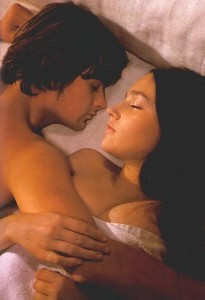Romeo and Juliet (1968)
 Romeo and Juliet (1968) is Florentine director Franco Zeffirelli’s beautiful modern interpretation of Shakespeare’s enduring, classic yet tragic love story of “star-crossed lovers.” Filmed on location in Italy, it was the most commercially successful Shakespeare film and its most entertaining, refreshing and natural rendition – a passionate celebration of young love.
Romeo and Juliet (1968) is Florentine director Franco Zeffirelli’s beautiful modern interpretation of Shakespeare’s enduring, classic yet tragic love story of “star-crossed lovers.” Filmed on location in Italy, it was the most commercially successful Shakespeare film and its most entertaining, refreshing and natural rendition – a passionate celebration of young love.
The film won four Academy Award nominations for Best Picture, Director, Cinematography (Pasqualino De Santis), and Costume Design (Danilo Donati), winning two Oscars – Best Cinematography and Costume Design. Nino Rota’s evocative musical score, including a period ballad “What is a Youth” (with lyrics by Eugene Walter) was un-nominated.
The earlier 1936 MGM, George Cukor-directed version of the film, starring Leslie Howard and Norma Shearer, or the 1954 British-Italian version (with Laurence Harvey and Susan Shentall as the lovers) cast much older, more mature lovers in the starring roles. The story was refashioned in director Robert Wise’s and Jerome Robbins’ West Side Story (1961) as a tragic tale of conflict between two warring rival NYC gangs, with Richard Beymer and Natalie Wood. It was recently remodeled with a radical, MTV-style and rock soundtrack in Baz Luhrmann’s unconventional William Shakespeare’s Romeo + Juliet (1996), starring Leonard DiCaprio and Claire Danes as the young lovers in a late 20th century setting.
With brilliant forethought, Zeffirelli gambled by filling the two starring lead roles with two young unknown and fresh-faced teenage actors: 16-year old Olivia Hussey as the stunningly beautiful, dark-haired Juliet (just a few years older than Shakespeare’s Juliet – a “fortnight and odd days” from 14), and 17-year old, slender and blue-eyed Leonard Whiting as Romeo. It retained the exciting feuding scenes between hot-headed members of the opposing families, the ineffectual but well-intentioned Friar Laurence, Juliet’s bawdy Nurse, and the double-suicide of the youths. Laurence Olivier served as the uncredited off-screen narrator.
Although much of Shakespeare’s dialogue was cut for the film (including much of Juliet’s potion speech in Act IV, Scene 3, and the death of Paris in Act V, Scene 3), it appealed to the youthful, counter-cultural generation of the late 60s with its realism, the passion of the lovers, the brief nudity of the couple on their wedding night (morning), and its contemporary feel. The film’s reinterpreted modern message, coupled with youthful, idealistic, yet strong-willed and rebellious heroes heralding dreams of peace, love, and freedom, have made the two lead characters representative, anti-establishment icons.
The opening prologue sets the scene, outlines the action of the play and the ongoing, bloody feud which has broken out between two important families in Renaissance Verona, the poignant premonition that “star-crossed lovers” [Romeo – son of the Montague family, and Juliet – daughter of the Capulet family] will die by the tragedy’s end, and the reconciliation of the two bitter, warring families.
|
sanssouciblogs wrote on Oct 29, ’07
This was a hot one when it came out, beautifully done movie; I should see it again. Thanks, sis, for a wonderful revisit.
|
|
lauritasita wrote on Jan 5, ’08
This was always one of my favorite movies !!!
|

Comments
Romeo and Juliet (1968) — No Comments
HTML tags allowed in your comment: <a href="" title=""> <abbr title=""> <acronym title=""> <b> <blockquote cite=""> <cite> <code> <del datetime=""> <em> <i> <q cite=""> <s> <strike> <strong>